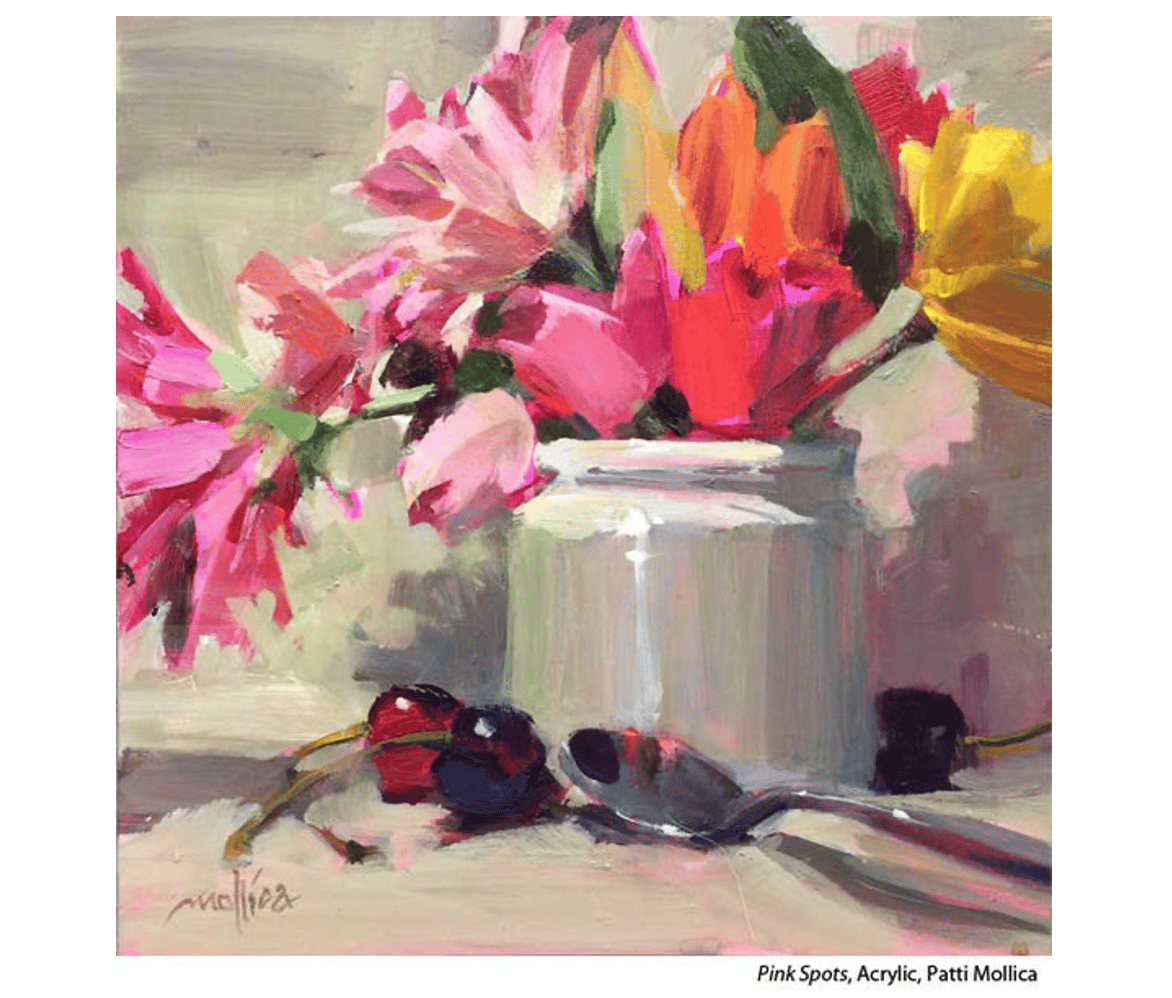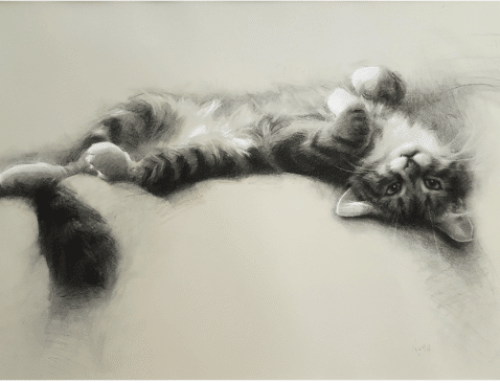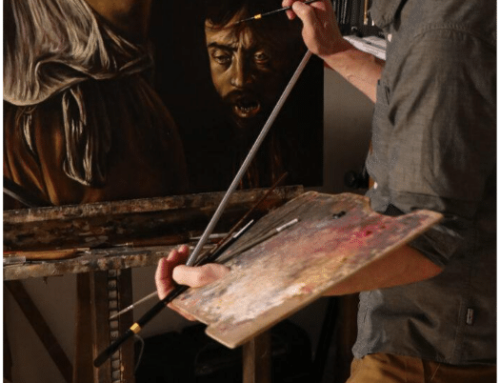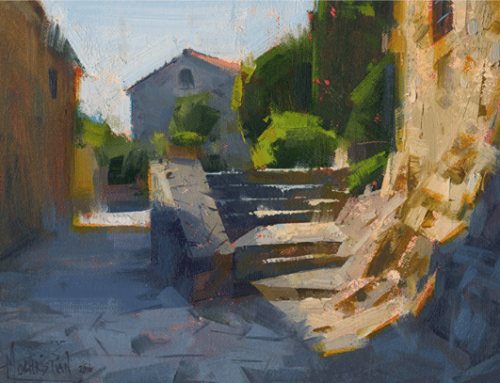Patti Mollica has always been interested in drawing. That skill came in handy during her 30 years as a graphic designer. But as technology changed, Mollica found herself dissatisfied with where the graphic design industry was headed and decided it was time to get back to her first love, art. She’d always drawn and used pastels, but after she started taking workshops, she eased herself out of her commercial career and into a new and still more creative track as a self-made professional painter.

What does a typical day look like?
Truthfully, I don’t have any typical days. Each day depends on what I’m working on which is determined by the most urgent deadline.
I juggle a lot of different types of jobs. Here are some: I just authored my 4th book in 5 years – for Northlight books; I am a commercial illustrator and work on all sorts of paintings for advertising agencies, book companies, magazines, etc.; I have a full schedule of teaching painting workshops all over the U.S. and abroad – at least one workshop per month; As a Certified Golden Working Artist, I offer lectures to art organizations, colleges and universities on acrylic paints and textural additives; I am represented in several art galleries, both nationally and abroad; private commissioned assignments; social media and marketing are required to raise awareness for my workshops; and last but not least – PAINT! I paint almost everyday, because all my other jobs are based on being an artist.
How did you learn to paint? Are you self-taught?
I’m not entirely self taught. Starting in 1995, I’ve taken painting workshops, the first being with Charles Sovek. Until then I had worked primarily in graphite and pastel. After the first workshop I took several painting classes at the art students league in NYC and also won a scholarship at the National Academy of Art.
During that phase, I painted clothed and nude models from life with teachers that pushed strict realism. I think this is a great method for learning how to be accurate and develop an ability to render complex forms, although it does very little for finding your voice. Self- teaching and finding your own direction is the best way to develop your unique style, in my opinion.
I started drawing at an early age and therefore had enough skills to be able to translate concepts accurately into paint, and develop a style that fit with my busy schedule and lifestyle. I am most drawn to subjects that are not commonly thought of in an artistic light. In that sense, I am more inspired by these types of subjects than the those that are already postcard-pretty.
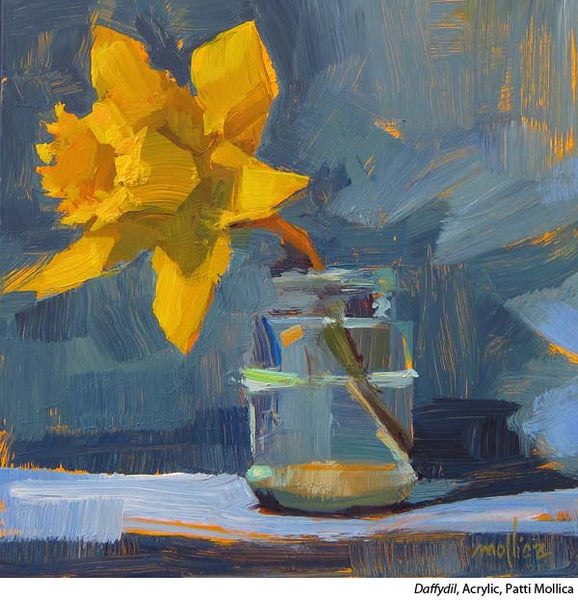
You had a day job for many years. How did you decide to have a day job and what did that bring to your work? Why did you end up focusing solely on painting?
For over 30 years my day job was being a freelance graphic designer. I worked for all sorts of clients – but towards the later part of that career I specialized in the financial services industry, mostly providing advertising and marketing materials for Wall Street firms.
I transitioned out of graphic design as internet technology took hold and the focus shifted from solving visual communications problems to learning complex code and new technical skills. As my job became less and less creative, I realized it was time to get back to my first love, art.
My years as a graphic designer and the skills I honed as a result, provided the best possible solid foundation for a career in painting. Many artists have said that the best painting composition must rest on a great underlying design. I spent so many years honing design skills which translated seamlessly to painting.
This is the crux of what I teach in my workshops – learning how to design your paintings. Once you learn how to do that, everything else is easy. Most artists I work with have never been taught how to design. In my opinion, it’s the foundation, the most important aspect of your painting.

What role does drawing play in your work? Why is drawing important?
Drawing plays a very significant role. I developed good drawing skills at an early age. These skills allow me to be loose because my paintings have accuracy in underlying drawing skeleton. If the drawing is reasonably correct, you can paint much more playfully loosely over it.
Many people come to art later in their life, and want to skip the rigor of learning how to draw – they just want to play with paint and color. They will only get so far in their evolution – basic drawing skills are required if one wants to paint in a representational manner. I’m not saying that one has to be able to render with perfect exactitude but learning how to draw is important.
You paint many different subjects. How do you decide what to paint next? Do you work in series? And if yes, why?
I seem to choose my subjects in phases, for no particular reason.
Urban landscapes always intrigue me because of the energy and movement. However they are the most complicated, so when painting them the challenge is about abstracting and simplifying. Sometimes I do city scenes from life, but from a logistical standpoint its much easier to work from a series of photos I have taken. Rarely do I work from one photo – I swipe and exchange cars, pedestrians and signage from other photos on hand to with help the composition and focal point.
Sometimes I like to switch things up by setting up a still life and having control over the subject choices, the colors and the lighting. This is basically an exercise in painting what I see and “coaxing out” it’s most alluring qualities. Some of my paintings are in a series based on size, subject and dominant colors.

Being an artist takes a lot of focus and energy. It can be so easy to let the outside world distract you or get lost while transitioning between one thing and the next even within art. How do you keep art at the center or your day? How do you stay focused throughout your day? Is that easier now that you’re established?
It is not very difficult for me to stay focused. Every project I work on has tight deadlines attached. That’s what keeps me in line. From my graphic design/advertising career, I am no stranger to tight deadlines and producing quickly. Being established only adds more to the “to do” list, with more deadlines. I have to do everything fast – including paint. That’s the real reason I paint “Fast, Loose and Bold”… out of necessity.
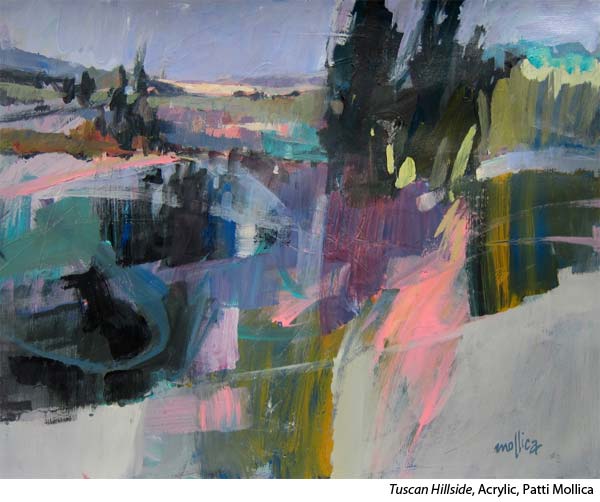
Value and color can feel overwhelming to a beginning artist. How does an artist get a command of those technical aspects of painting?
I strongly recommend focused practice with the appropriate exercises to help a student learn as quickly as possible. In my opinion, there is nothing more important than learning drawing, values and finally, color. These can be learned thru targeted exercises. Playing and exploring is also very important, and we all need to do that too. But if the goal is to progress to certain levels quickly, targeted focus on the right types of exercises will lead you to your goal.

Building on that: What role does planning play in your work?
I do try to plan before I paint. First I plan out the values, with a simple sketch. I revise the sketch until it works and the design and composition holds together. I envision how my colors will work. Once that is accomplished, I feel confident to jump into the paint.
Sometimes I choose to translate colors to an analogous scheme, which lends itself to color harmony. I try to be aware of the warm/cool balance. If my subject’s actual colors aren’t working, I often push them one way or another to create a scheme that looks united. The freedom comes thru as a direct result of planning first. Once I feel confident (from having a good value sketch and a color concept) I feel much more willing to take spontaneous chances. Planning first helps with spontaneity.

What is the biggest challenge you see students in your workshops facing and what advice do you give to them?
Many students want to skip the fundamentals, especially the drawing and value skills. They want to paint and have fun with color. Learning to draw, design with a few simple values seems tedious and less creative.
If your drawing skills are not good, my suggestion is to draw a bit everyday. You WILL improve and it will inform your paintings. Drawing trains your eye to see.
If you are not familiar with how to design in values, start working in three values – black, grey and white. Until you can do some successful work in thre values, wait on the color. This is one of the best ways to learn strong design and composition. Good painting is all about the fundamentals – it does not serve any artist in the long run to skip the fundamentals.
Check out the teaching videos by acrylic painter Patti Mollica, or learn more about her by visiting her website, blog and Instagram page.
Accused Spanish Forger On Trial for Faking Munch, Others
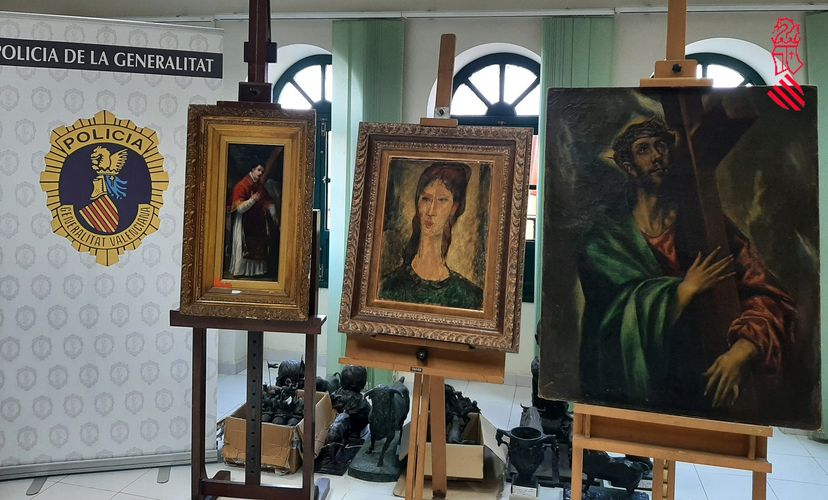
Three forged painting seized by police in Toledo, Spain in March, 2022. Courtesy of the Valencian Generalitat Police.
A Spanish collector is facing years of prison time for allegedly forging and consigning artworks by Roy Lichtenstein, Edvard Munch, and others, according to a story in Artnet.
Guillermo Chamorro, aged 67, is being charged with intellectual property theft and fraud related to the falsification of 15 works of art, according to Spanish newspaper El País. The prosecutor’s office in Madrid, where the trial is taking place, is seeking a six-and-a-half-year prison sentence. A once respected collector and occasional artist, Chamorro has now been connected to dozens of suspected forgeries going back several years.

